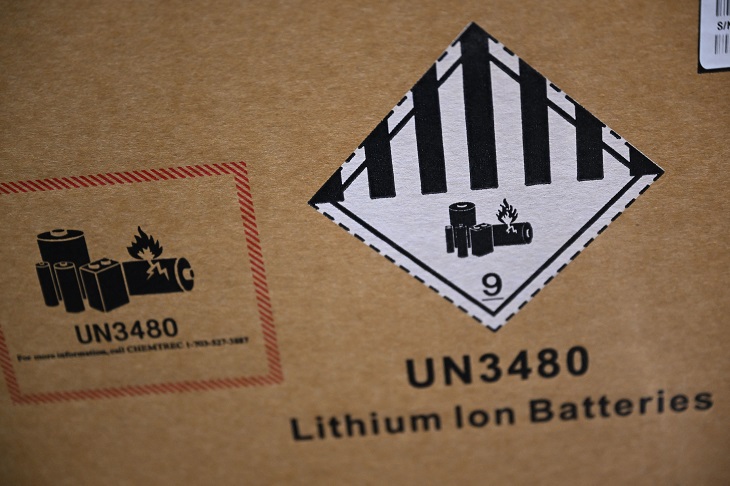The development of lithium-ion batteries has changed the concept of energy storage. As their use expands, a potential downside is becoming more apparent, with resulting fires proving difficult to control and human lives being put at risk. House fires, car fires, and ship fires emphasise the scale of the problem.
A recent fire on the Japanese cargo ship Fremantle Highway demonstrated the potential threat. The ship, which was carrying 3,793 cars of which 398 are EVs, burst into flames on July 26. One crew member died and 20 of 22 required hospitalisation. The fire, although its source is yet to be confirmed, is suspected to have come from lithium-ion batteries. It burned for 5 days, but fortunately the damage did not extend below the waterline. The stricken vessel has been safely towed to port. Fighting these fires on land is difficult enough, but in the confines of a ship, is hazardous in the extreme.
This is not an isolated example. There were 209 ship fires in 2022, an increase of 17 per cent in 2021, 13 were car carriers although not all had electric vehicles onboard. An estimated 8 ships have sunk recently with battery fires suspected of playing a role, including the Felicity Ace, with 4,000 cars on board, that sank in 2022. These events compare with around 50 ships sinking each year of varied causes. Insurance premiums are rising and specific measures for EV fires being mandated.
We think of batteries as solar or wind renewable energy storage, but these batteries are now incorporated in a range of devices, including mobile phones, computers, power tools, garden tools, domestic appliances, even torches. In 2021, a torch battery fire was suspected of leading to the loss of a house in Australia. The push for electric vehicles means their number is increasing, with hybrids having a similar risk to full electric vehicles. And it is not only cars. There has been a number of E-scooters and electric skateboards, many cheap with unknown quality controls during manufacturing, sparking fires. The reality is that charging equipment should not be left unattended, although that is a demand unlikely to be fulfilled.
The ACCC is currently investigating product standards, with some imported brands recognised as having an increased risk of overheating and catching fire. A survey of 5,000 homes revealed 2,900 contain potentially risky battery brands and other problems with their overcharging. A further 10,000 batteries were found in need of replacement by the manufacturers, many of which were being used for solar storage. The question of their disposal is also uncertain, with landfill fires a risk. Fires have even been reported in the garbage trucks taking them to the tip, and there are concerns we could see special storage facilities catch alight.
Many Australian stores, such as Aldi, Bunnings, OfficeWorks, and Woolworths have collection points for old batteries, but the potential risk is unappreciated. 99 per cent of lead-acid batteries are recycled, the figure for lithium-ion batteries is roughly 10 per cent, with lithium waste growing by 20 per cent each year. This accumulation is expected to reach 136,000 tonnes in Australia alone, with what risk coming from these storage facilities?
In America, where the standard is being set, figures from New York show the number of battery-related injuries from popular e-bikes is increasing, 13 in 2019, rising to 79 in 2021, and already 114 in 2023. There have also this year been 74 injuries and 13 deaths. In Vancouver, a similar tale is emerging, with battery fires increasing 5-fold since 2016.
Australian figures are also on the rise, with lithium-ion batteries being responsible, in 2022, for 180 fires in NSW, 120 in Victoria, 72 in Queensland, and 59 in WA, countrywide over 450 fires in 18 months. The scale of the risk is increasing dramatically, compounded by 75,000 E-scooters sold in 2022, some of dubious quality, with battery contaminants increasing the threat.
The fire risk occurs primarily, but not only, when batteries are recharging. Other risk factors include storage in hot or wet environments – a hot summer or submersion by flood is sufficient – or physical damage, leading to leakage of the pressurised flammable electrolyte. They are also sensitive to salt in the air during sea voyages. The usual predisposition is overcharging, particularly when using so-called fast chargers, with heat leading to thermal runaway and temperatures up to 500C.
Water is much less effective in controlling these blazes, as much as ten times more, around 150,000 litres, is needed to suppress the flames from a car battery, cool the battery, and prevent the spread to adjacent cells and explosion. Having put out the fire, spontaneous re-ignition has occurred, up to 22 hours later. High performance EV cars can keep catching on fire a week after a crash. As explosions from these types of fire throw burning fragments over 10 metres, it is necessary to store the doused battery at least 20 metres away from other flammable materials.
A new, expensive fire extinguisher, which also works on standard fires, is more effective. The F500 model contains an ‘encapsulating agent’ which interrupts the ‘free radical chain reaction’ – it works! For vehicle fires, a Swedish company suggests an ultra-high pressure water lance, penetrating the battery shell, this may prove an effective alternative.
There have also been problems with giant storage batteries being collected from solar and wind farms. Whilst building the Victorian big battery in 2021, coolant leaked out, and the resulting fire destroyed 2 of the 212 energy storage units. There have been fires at AES facilities in Arizona, the first was in 2019 and the second in 2022, lasted for ten days. A few days ago, a fire at a lithium-ion, solar farm storage facility in New York took 4 days to bring under control. With the highest per capita level of battery storage, and 33 large batteries, Australia is technologically well advanced but, as these facilities become the major back-up for electricity grid stabilisation, the fire risk assumes greater importance.
Unsurprisingly, fires are also occurring at lithium battery factories and storage warehouses. In January this year, an explosion took place at a French lithium battery warehouse, containing 8,000 batteries, in Rouen. In Gothenburg, Sweden, a fire in a container containing 9,000 kg of standard lithium batteries took several days to control. In Jacksonville, USA, in May, a fire started by a 9,000 kg mega-battery took several days to extinguish, consuming the factory it powered.
One solution being explored is a lithium/iron/phosphate battery. LFP batteries are less energy dense than lithium-ion, but appear more stable and safer to charge, with less risk of thermal runaway, and fire. They last longer but unfortunately, as they do not contain valuable cobalt, they are even less likely to be recycled.
As was the case with the big battery fire in Victoria, the media’s almost total disregarding of what is an increasing threat to life and property seems to have but one explanation – in the climate ‘crisis’ electric cars are good, battery storage of solar and wind is good; any problem remains unreported. The consequences of increased mining and manufacture exacerbating CO2 emissions, and the lack of recyclability, do not fit the climate agenda and are ignored. We can but hope that the ACCC review shines a spotlight on what is a ticking time bomb, with echoes of the hundreds of fires of the belatedly cancelled Pink Batts fiasco.
Got something to add? Join the discussion and comment below.
Get 10 issues for just $10
Subscribe to The Spectator Australia today for the next 10 magazine issues, plus full online access, for just $10.


























Comments
Don't miss out
Join the conversation with other Spectator Australia readers. Subscribe to leave a comment.
SUBSCRIBEAlready a subscriber? Log in